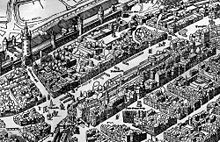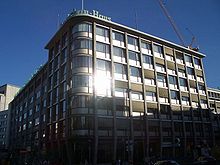Eschenheimer Tor
| Eschenheimer Tor | |
|---|---|
| Place in Frankfurt am Main | |
 Eschenheimer Tower at Eschenheimer Tor |
|
| Basic data | |
| place | Frankfurt am Main |
| District | Downtown |
| Created | around 1810 |
| Confluent streets | Große Eschenheimer Strasse , Schillerstrasse , Taubenstrasse, Stiftstrasse , Hochstrasse , Bleichstrasse, Eschenheimer Anlage, Bockenheimer Anlage , Oeder Weg , Eschersheimer Landstrasse |
| Buildings | Eschenheim Tower , Bayer House, Tower Palace, "Metropolis", Landw. Rentenbank |
The Eschenheimer Tor is a square in Frankfurt am Main on the northern edge of the city center, about 400 meters north of the main guard .
The square was created around 1810 with the demolition of the Frankfurt city fortifications from 1333 as well as its baroque bastions and the redesign of the fortification ring into a green area, the ramparts . In its center stands the most representative gate tower of the Gothic city wall, the Eschenheimer Turm ( Klaus Mengoz and Madern Gerthener , 1400–1428). It is the scene of the popular tale of the nine in the weather vane . The development around the square dates from the 1950s, with the exception of the adult education center. In the middle of the square is the Goepfert fountain on a traffic island inaccessible to pedestrians, a fountain designed by Hermann Goepfert in 1968 .
Confluent streets
The square is now one of the busiest intersections in the city. Ten streets flow into it:
-
Intra Muros
- The Large Eschenheimer Street , the main street of the old town to the north gate;
- the Schillerstrasse , pedestrian zone and at the Frankfurt Stock Exchange ;
- the Taubenstraße that leads from the southwest to the square;
- the Stiftstraße the southeast shopping street Zeil and on to the Cathedral leads here in the 1950s, the famous prostitute had Rosemarie Nitribitt her apartment;
-
In the course of the former fortifications
- the elevated road (west) and
- the Bleichstrasse (east of the gate), which follow the course of the late Gothic city wall in their straight line ;
- the Eschenheimer plant (east) and
- the Bockenheimer Anlage (west of the gate), which to this day retrace the jagged course of the (no longer existing) bastions of the 17th century,
-
Extra muros
- the Oeder Weg , the former way from the city gate to the moated castle of the patrician families Holzhausen and Stalburg , today a busy shopping street in the north end ;
- the Eschersheimer Landstraße , the continuation of the Große Eschenheimer Straße outside the walls and then as now one of the most important arterial roads in the city.
The streets Hochstrasse and Bleichstrasse ( clockwise ) and Eschenheimer and Bockenheimer Anlage (on the other hand) are part of the innermost ring road, the system ring or city ring named after the ramparts .
The intersection of Eschenheimer Anlage, Bockenheimer Anlage and Eschersheimer Landstrasse in the northern part of the square is also the border point between the city districts of the city center (south), Westend-South (northwest) and Nordend-West (northeast).
Public transportation
Local railway
From 1888 to 1908 a 5.5 km long steam tram operated by Frankfurter Lokalbahn AG ran between Eschenheimer Tor and Eschersheim . The single-track line, popularly known as Knochemiehl , was sold to the city of Frankfurt in 1901 and electrified in 1908.
tram
From 1908 to 1963 the Eschenheimer Tor was an important junction for the city's tram . About the Eschersheimer Landstrasse drove u. a. lines 23 (to Heddernheim ), and lines 24 (to Oberursel -Hohemark) and 25 (to Bad Homburg ) operated jointly with Frankfurter Lokalbahn AG until 1954 . The junction into Oederweg was used by line 12. With the start of the underground construction in 1963, tram traffic at Eschenheimer Tor was stopped.
Subway and train station
The A-route of the Frankfurt U-Bahn , which is now used by the U1 to U3 and U8 lines , has been running under the Große Eschenheimer Straße and Eschersheimer Landstraße since 1967 . The route tunnel was led past the foundations of the Eschenheim tower a few meters to the west .
The Eschenheimer Tor underground station is located directly below the square, in the area of the ramparts. It was created from 1963 and opened in 1968. The then transport planning envisaged a broad unbundling of pedestrian traffic from automobile traffic. Accordingly, a large underground distribution level (B level) was created under the entire square, which not only serves as access to the subway. Pedestrians should also descend into the plain in order to cross the square. In the meantime, however, there are also pedestrian crossings above ground.
The subway station itself is kept in the simple style of the 1960s , straight lines and right angles determine the design. It has two side platforms of medium width, which are connected to the distribution level via fixed and escalators .
building
Eschenheim Tower
The most famous building at Eschenheimer Tor is the Eschenheimer Turm , one of the city's landmarks. It is oriented towards the Oeder Weg , to the former Holzhausener and Stalburger Oede . The tower stood inaccessible for about 30 years on a traffic island in the middle of car traffic and was only connected to the pedestrian zone Schillerstrasse in the early 1990s . Since then there is a bar with a restaurant on the ground floor.
Former people's education center
On the north side of the square, between Eschersheimer Landstrasse and Oeder Weg, is the former Volksbildungsheim, which at times also housed the Hoch Conservatory , from 1963 to 1995 the Theater am Turm (TAT) and the well-known TAT café. Today it houses the large cinema (Metropolis) . This prestigious neo-baroque building was built 1907- 08 , designed by F. Vietze and W. Helfrich. Until it was destroyed in 1944, like many large buildings in Frankfurt, it had a striking mansard roof that was not restored after the war. From 1996 to 1998 the people's education center was converted into a large cinema by the Albert Speer and Partners office .
Bayer House
The Bayer-Haus , the self-confident representation of the chemical company in the hometown of its competitor Hoechst AG , was built in 1952 according to plans by Stefan Blattner on the east side of the Eschenheimer Tor. The eight-storey building has a huge, massive-looking flat roof that rises towards the square and protrudes widely . The top, very high office floor below is fully glazed and set back from the facade, creating a kind of terrace. Since the beginning of 2008, the listed building has housed Fleming's Hotel Deluxe with a restaurant on the top floor.
Tower Palace
To the south, between Bleichstrasse and Stiftstrasse, was another large cinema, the Tower Palace . In its place stood the UFA-Groß-Frankfurt, which was destroyed in the war and which arose from the renovation of the Frankfurt Operetta Theater in 1929. The new tower palace was opened on March 30, 1950 and in the following years the site of numerous film premieres. Among other things, the films Die Sünderin (1951) and Moselfahrt aus Liebeskummer (1953) were shown to the public for the first time. The cinema was most recently known for showing films in the unsynchronized original version. The tower palace formed a building complex with several residential buildings, one of which has striking, large-area neon signs that characterize the square. The cinema closed at the end of June 2010. In November 2012, the building complex on Bleichstrasse was demolished.
Rundschau house
Again directly south of it, on the corner of Große Eschenheimer and Stiftstraße, was the Rundschau House , which until July 2005 was the seat of the editorial and publishing house of the daily newspaper Frankfurter Rundschau . (W. Berentzen, 1953). It was one of the most valuable examples of Frankfurt post-war architecture and, together with the neighboring Wilhelminian-style commercial building Große Eschenheimer / Schillerstraße, formed the striking southern end of the square. The building was demolished in May 2006. The entire area between Stiftstrasse, Großer Eschenheimer Strasse and Zeil will be redeveloped by 2009 as part of the Palais Quartier project .
Agricultural pension bank
To the west of the square is the building of the Landwirtschaftliche Rentenbank , built in 1955/56 .
spelling, orthography
The different spelling of the various objects named after the district of Eschersheim is not a typo, but a special feature that is well known in the city:
- All objects within the former walls are written “Esche n heimer” (with n ): Eschenheimer Turm, Eschenheimer Tor, Große and (the former, no longer existing) Kleine Eschenheimer Straße, Eschenheimer Anlage;
- All objects outside the former walls are written “Esche rs heimer” (with rs ): Eschersheimer Landstrasse, Frankfurt-Eschersheim, Alt-Eschersheim.
Web links
- Harald reports: Eschenheimer Tor - photos of the construction of the post-war buildings around the gate
swell
- ↑ Frankfurter Rundschau of November 27, 2012, ( online ), accessed on November 27, 2012
Coordinates: 50 ° 7 ′ 2 ″ N , 8 ° 40 ′ 45 ″ E






